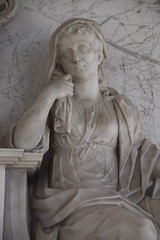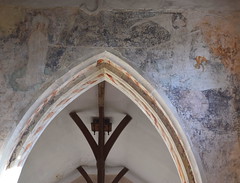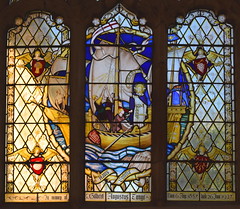| |
|
 |
|
Given its proximity to the
Cambridgeshire border, some people would argue
that this Suffolk church is closer to
civilisation than most, and yet St Margaret of
Antioch, Cowlinge, has a decidedly remote feel to
it. Gentle hills enfold these pretty villages,
and St Margaret stands distant from the houses it
serves. Cowlinge, pronounced coo-linj,
stands about a mile north of the Haverhill to
Bury road, not far from the better-known villages
and medieval churches at Denston and Lidgate. You
approach St Margaret up a track from the north,
where it is rather hemmed in, but the graveyard
opens up widely beyond on the other side.
The first impression is one of redness. From the
outside, Cowlinge seems a rather pretty accretion
of centuries' work, its tower a typical red brick
18th century rebuilding - there are similar ones
across the county at Grundisburgh and Layham. The
west doorway is oddly grand for such an
out-of-the-way spot. The high eastern gable shows
that the chancel roof was once thatched, while
the chancel and nave appear to have met each
other by chance as much as intention. All is
pleasantly patched up, with solid red-brick
buttressing and just about every kind of window
you can think of. There
are aisles, there is a clerestory, but this is
not a grand church. Rather, it is the kind of
building a DIY enthusiast might put together if
he wanted a late medieval one in his back garden.
|
And somehow, this makes it
beautiful, especially if seen from the south-east or
north-east. You might expect the interior to be similarly
ramshackle, but you step through the north door into cool
whiteness, and as you walk through this treasure chest of
a church, unusual vistas open up at each turn. This is a
complex church.
Facing east to start with, the
first impression is of the wall-painting above the
chancel arch, and the gated rood screen beneath. There
are gates in the screens at nearby Withersfield and
Denston, but unlike those these doors rise to the full
height of the screen. The screen itself is perhaps not as
beautiful as the parclose screen enclosing the chapel in
the south aisle. Mortlock points out how similar it is to
the one up the road at Dalham. The paleness of the wood
is very pleasing.I thought it compared very well with the
parclose at Dennington, which has been repainted gaudily.
Another good parclose of the same age is at Westhorpe. A
memorial window contains 1920s glass by Christopher Webb
of Christ standing in the boat with the fishermen at
Galilee, a pennant of the newly-founded Diocese of St
Edmundsbury and Ipswich fluttering at the stern.
One the wall beside the parclose in the south aisle is a
small exposed area of wall painting. It appears to be an
unbearded male saint holding something that may well be a
chalice, in which case it is St John the Evangelist. The
better-known wall painting here is the one I mentioned
earlier, above the chancel arch.
| This is often referred to
as the Cowlinge Doom, but it is organised rather
differently to other doom paintings of its kind.
Instead of the day of judgement, with God in
Majesty overseeing the parting of the ways into
hell on his right and heaven on his left, it
depicts St Michael, to the south of the arch,
balancing a set of scales in which a sinner is
being weighed against his sins. St Michael is a
common feature of doom paintings - he appears
nearby at Stoke by Clare and on the famous doom
at Wenhaston. The unusual aspect of this one,
however, is to the north of the arch, where the
Virgin Mother of God stands. She reaches out with
a wand, and tips the balance of the scales. Simon
Jenkins, in his England's Thousand Best
Churches, suggests that she is tipping the
balance in the favour of the virtuous. This is,
of course, exactly what she is not
doing. The virtuous had no need of intervention;
the good in them would outweigh their sins in any
case. Mary is intervening on behalf of sinners
who have prayed to her for her help, and she is
tipping the scales in the favour of those
sinners. It represents the efficacy of
intercessions to Our Blessed Lady, and as such it
was anathema to the 16th century reformers. |
|
 |
In common with other wall
paintings, this priceless art treasure was whitewashed
over rather than destroyed. It would be interesting to
know when this happened. We know that during William
Dowsing's iconoclastic progress through Suffolk and
Cambridgeshire in 1644, he found no wall paintings still
in existence. It has always been assumed that they were
covered by the Anglicans when the new Church of England
took possession of our parish churches a century earlier.
But I do wonder if they might have been done away with a
century before even that, perhaps around the middle of
the 15th century, when the ruling classes were enforcing
orthodox Catholic dogma in the face of the superstitions
of the ordinary people. Part of this process involved
setting up larger roods at the east end of the nave, and
I think this wall-painting may have been covered before
that happened here.
The chancel arch beneath the doom is also extensively
painted, and also of interest on all of the pillars a
large amount of medieval graffiti, some of which is
described as being consecration crosses. This, of course,
cannot be so, for the medieval church ordered its
liturgical needs rather better than this, and these are
no doubt the work of some bored 17th century vandal.
Stepping through into the chancel, it is at once one of
the loveliest in Suffolk, and one of the most dominated,
since Peter Scheemakers' ugly 18th century memorial for
Francis Dickins glowers against the north wall. Dickins
was responsible for the building of the tower. The
figures are life size, and the monument is wholly
secular, even pagan. They look like nothing so much as a
couple on their way to a toga party pausing to pose with
the FA Cup.
| Near the north door, a
plaque on the wall records the visitation of 1618
when permission was given for the local house of
correction to set up seating here for its
inmates. There are still banked benches below,
but these are later, and were probably intended
for the village schoolchildren. Seating on a
similar scale can be seen at nearby Kedington,
divided there into boys' and girls' sections. On
a somewhat larger scale they can also be seen at
Laxfield. A fine view
of the interior can be had by climbing to the
spacious gallery beneath Dickins' tower. Once up
here, the space is dominated by another huge
classical memorial to Dickins and above it a
George II royal arms, which also records that
George Finton and Henry Seabrook were the
churchwardens who set it up in 1731.
St Margaret is everything a historic church
should be. Well-ordered, welcoming, suited to its
Protestant present and mindful of its Catholic
past. It used to be left open all the time, but a
traumatic assault on the building some five years
ago by a mentally ill man suffering from a
religious mania, during which both screens and
the altar were set fire to, means that it is now
kept locked, but with a very cheerful
churchwarden who was most happy to come and open
up.
|
|
 |
|
|
|

